Humans are encountering bears much more often than they used to. Although the risk of an attack remains very low, the number of fatal encounters is rising. With the bear population increasing and with more hikers on the trails post-pandemic, it’s essential to know the latest advice on what to do if you see a bear.
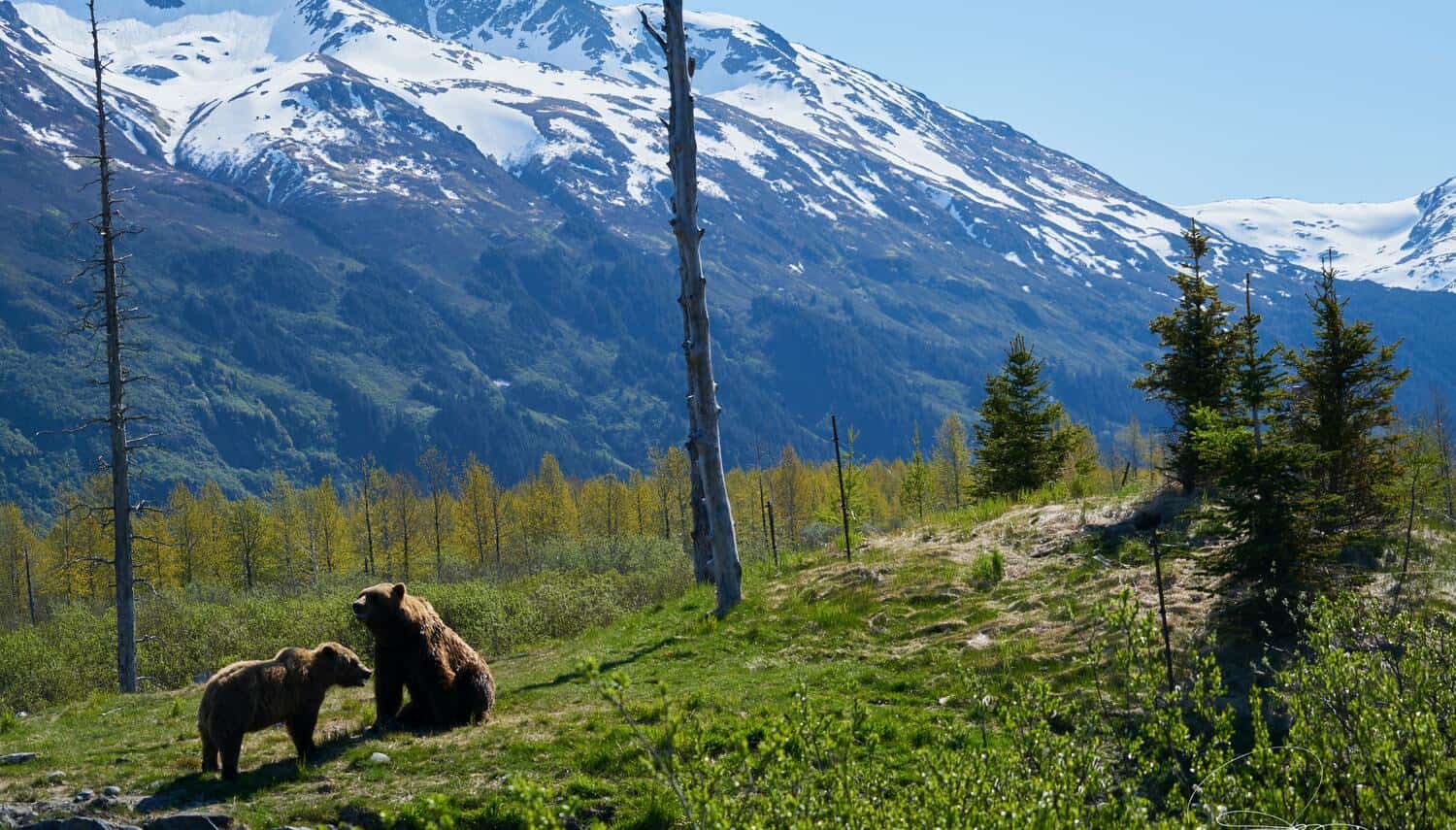
Much of what you think you know may be outdated. This article is the only thing you need to read to get yourself up to date.
It draws together the latest academic research and expert advice, condensing all of this into simple, practical steps so you can keep safe.
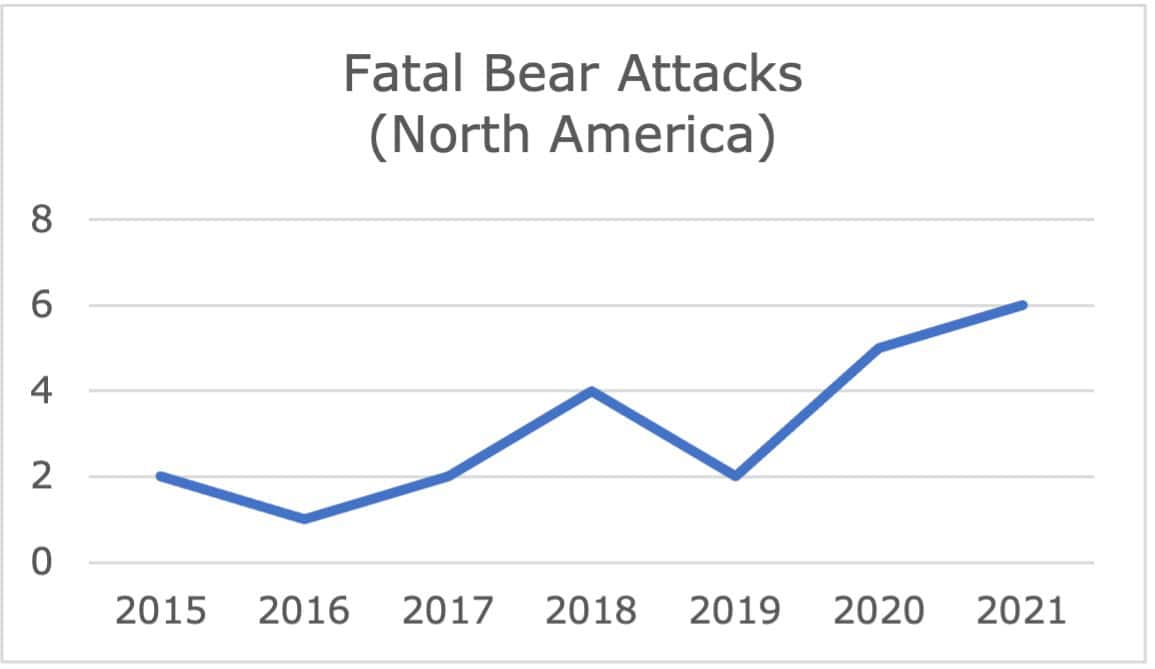
Table of Contents
Forget What You Thought You Knew
Society passes on a great deal of bad advice about what to do if a bear approaches you.
Perhaps the most famous is the adage: “If it’s brown, lie down; if it’s black, fight back.” Many bear experts have urged hikers not to follow this blindly.
Lying down or playing dead in a close encounter with a brown bear is particularly dangerous. It will not reliably deter a confrontation, leaving you utterly defenseless.
Other courses of action are far more effective at repelling a potential attack. Bear spray, in particular, is handy for keeping bears at bay (see tip #5 below).
You'll feel more at ease if you know that you can reliably defend yourself with it.
NOTE: Are you sure you know how to bear-proof your camp? You won't be able to rely on bear spray when you're asleep, so this list of tips on how to avoid bears while camping is a must-read.
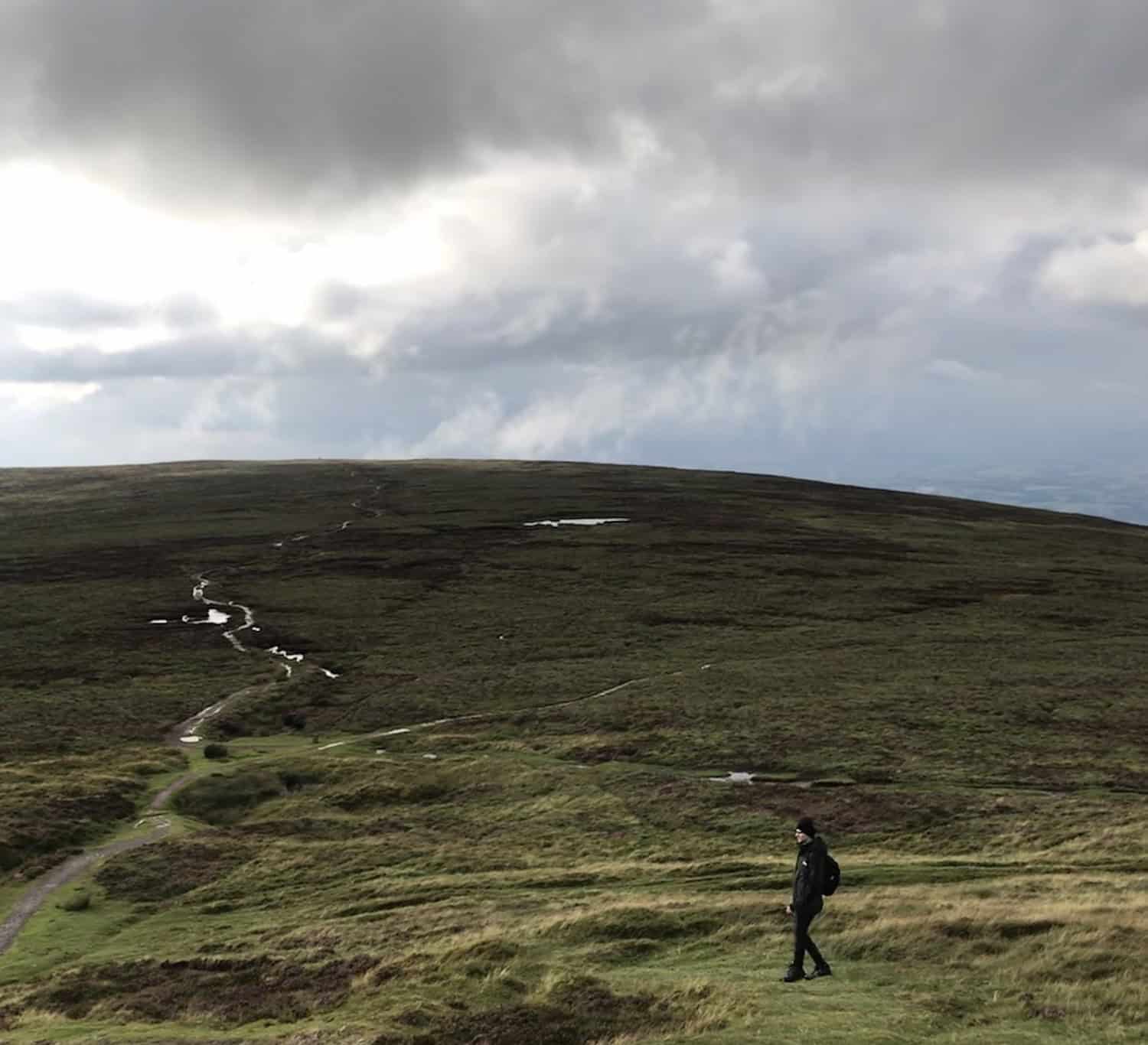
If It's Black, Fight Back?
The second piece of advice—“if it’s black, fight back”—is also problematic.
Black bear biologist Janet Scharhag argues that the best way of handling an encounter in bear country is by fighting back (you could throw rocks and wood, for instance). But she advises that you should only do so if a black bear is being aggressive.
Scharhag says that when a bear is attacking defensively (if you are near a mother bear's cubs, for instance), you should instead keep quiet and avoid threatening it.
This is all very well, but it’s not always so easy to tell apart a defensive from an aggressive attack in the heat of an encounter.
When the stakes are so high, it can be hard to trust yourself on such an important decision.
For this reason, all the advice given below will work with grizzly bears and brown bears (the most common species of bears in North America) in any situation.
NOTE: Polar bears are much more dangerous and require a wholly different set of skills, which you can find out more about here.
What To Do if You See a Bear: 6 Key Tips
1. Keep Food Safely Packed Away
This is a preparatory tip and critical advice on what to do if you see a bear on the trail or at your camp site.
Store food safely in sealed containers to limit bear-attracting odors leaking out. Wipe down all cooking utensils after making food.
Some hikers recommend distracting the bear by throwing your food supplies at it, but the US National Parks Service strongly advises against this—it’s a bad idea for several reasons.
First, far from distracting the bear, it may, in fact, only serve to encourage it. Throwing a tasty morsel at a bear can tell it that there’s more where that came from.
Secondly, throwing food may only distract you rather than distract the bear. You won’t have much time to decide what to do during a bear encounter.
If you spend precious seconds fumbling in your backpack for your food stash, you may not notice shifts in the bear’s behavior.
You will also have less time to follow the important steps outlined below.
NOTE: Food containers should be sealed and kept clean. To keep your camp clean with less effort, read this list of easy camping dishwashing hacks.
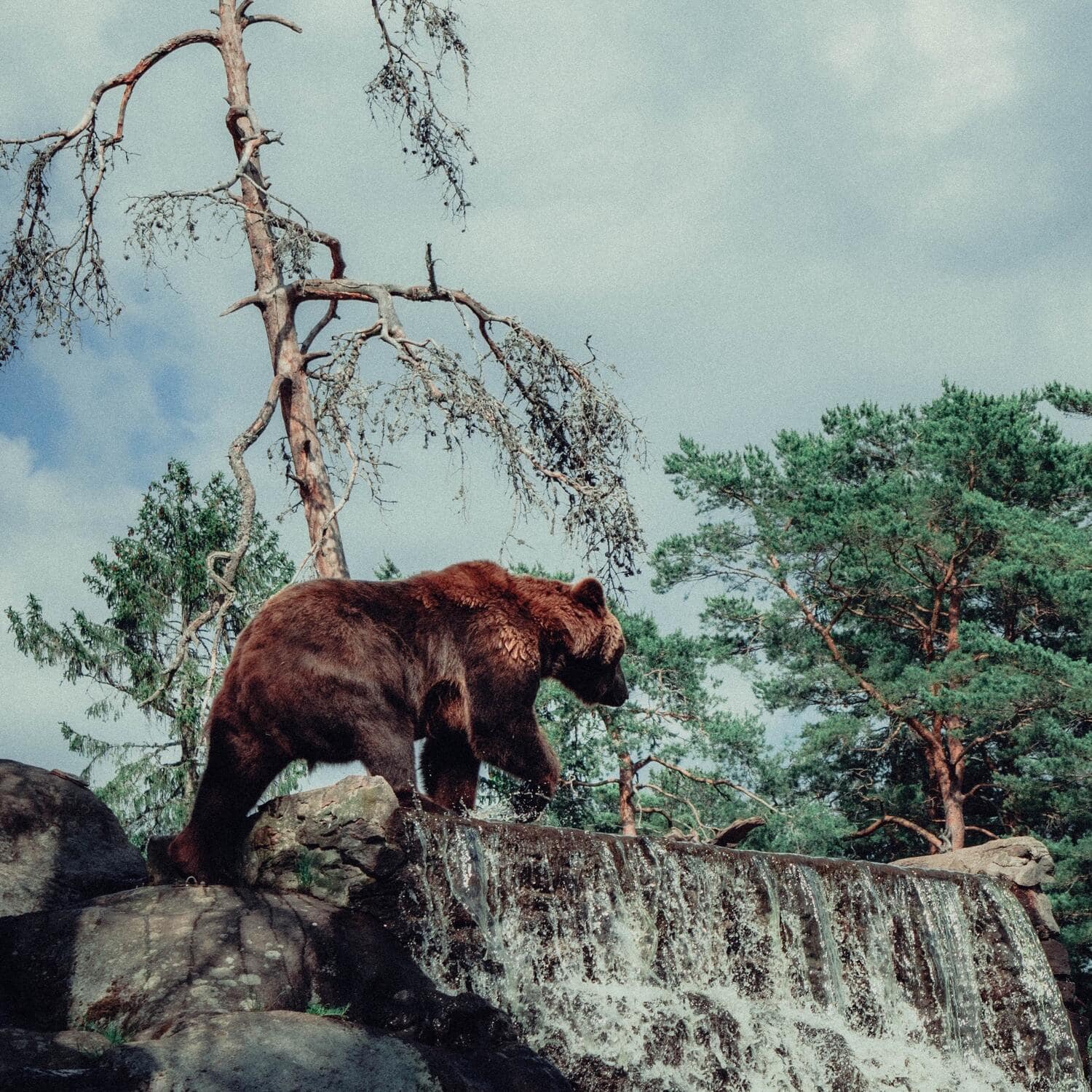
2. Keep Your Distance
Discussing what to do if you see a bear, experts ranging from bear biologists to the National Park Service highly recommend putting a safe distance of at least 75 yards between yourself and the bear as soon as possible.
But under no circumstances should you run. Like dogs, wild bears tend to chase things that flee. Given that they are much faster than humans, attempting to outrun one of them would be a bad idea.
A better strategy for handling a bear encounter is to walk sideways away from the bear.
Walking sideways allows you to maintain visual contact, enabling you to respond to sudden movements and sudden changes in its behavior.
Walking sideways is also less risky than walking backward because you can keep an eye on where you are treading. This would be a bad time to trip over!
Just be careful that your escape route does not come between a mother bear and her bear cubs. Unwitting provocation of a mother has been a significant factor in recent fatal bear attacks.
It’s also a good idea to leave your dog at home when hiking in bear country. Will a bear attack a dog?
Generally, bears will not attack a dog, but your dog may run too close to a bear cub and provoke a response.
Small children can also be unpredictable, creating potential dangers in bear country—so keep a close eye on them.
(If you're worried about bears attacking your dog at home, a good precaution is to give your dog pet food indoors so the smell doesn't attract them. You may also want to take down bird feeders for the same reason).
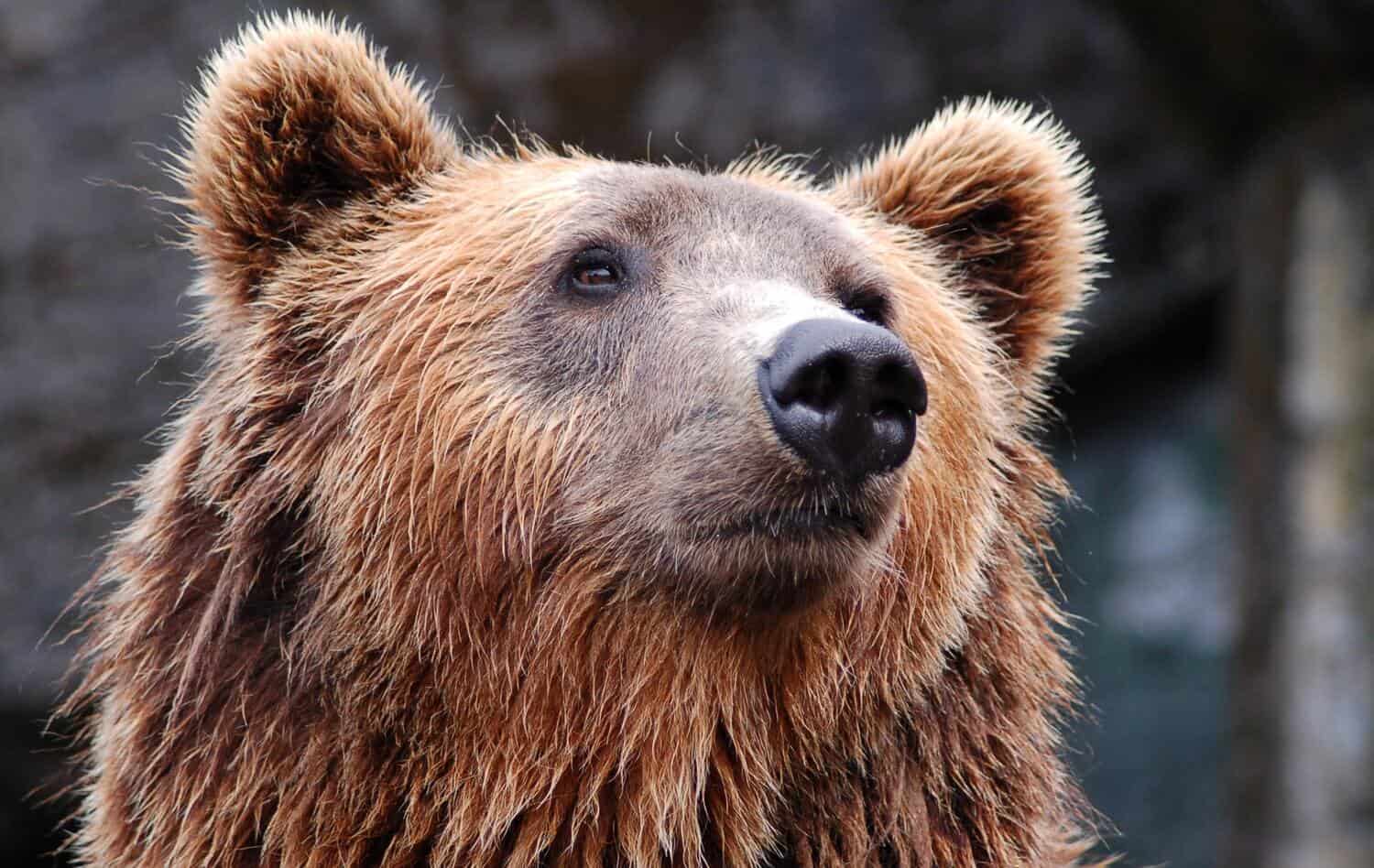
3. Speak Low and Loud
If you’re considering what to do if a bear approaches you, remember that bears do not consider humans prey.
Most wild animals, including bears (particularly black bears), seek to avoid encounters with humans, except in exceptional circumstances such as extreme hunger.
For this reason, it’s often more than enough to speak loudly and clap your hands when a bear approaches you.
Loud noises like these will immediately make it aware that you are not its typical prey, and in the vast majority of cases, it will make a hasty exit.
However, be aware that bears associate high-pitched sounds with prey, so it’s crucial not to shriek or scream but instead to speak in a low, loud voice when you are attempting to deter a bear.
4. Wave Your Arms Slowly
Waving your arms will make you appear larger to the bear. The larger you appear, the less likely it is to attack you.
By waving your arms slowly, you avoid surprising or inadvertently threatening the bear. As with the previous step, this is essentially a means of making it aware that you are not its usual prey.
Another way of making yourself appear larger to the bear is getting to higher ground.
Walk up any slope that is nearby while waving your arms. This will have a psychological effect on the bear’s perception of the risk of attacking you.
Similarly, if you have an umbrella with you, open it up and point it toward the bear to give the impression that you are bigger than you are.
Remember that a bear standing on its hind legs is more likely to be curious than preparing to attack. Bears stand up on their hind legs to get a better view of something or to catch a scent.
More reliable warning signs of an attack are when a bear opens its mouth wide or paws the ground.
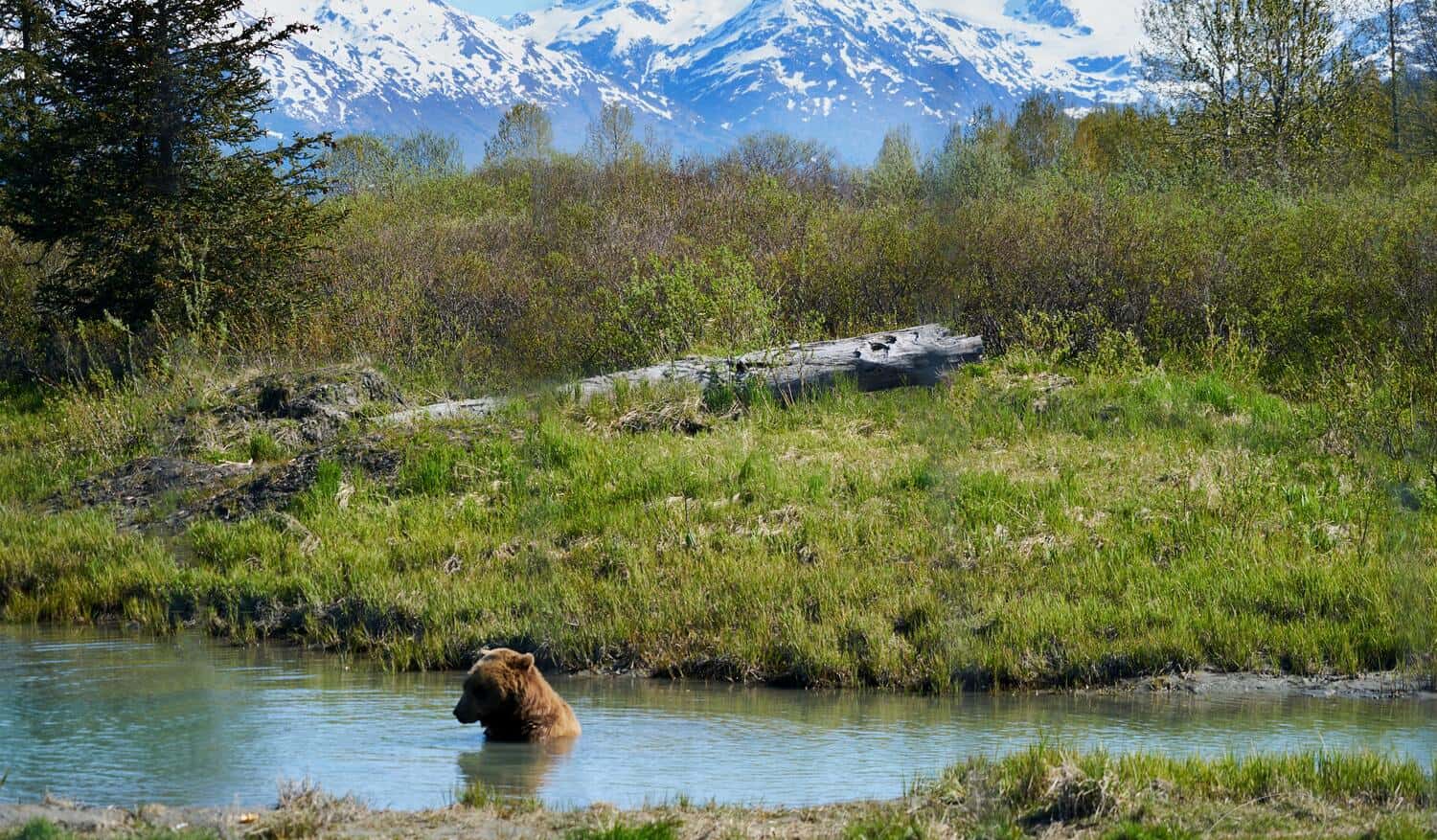
5. Use Bear Spray
Using a bear spray is our best advice on what to do if you see a bear.
Imagine this. You're out in bear country and you see a grizzly bear in the woods. You follow the four tips above, but for whatever reason, the bear doesn't leave you alone.
Maybe it's late summer and the bear hasn't put on enough fat for the winter. It runs at you. What do you do? It's best to have a bear deterrent with you in this dangerous situation.
Although grizzly bears and brown bears do on occasion make a bluff charge to scare off perceived threats, the best thing to do at this point is actively defend yourself.
Bear spray is the best bear deterrent and your best chance at defending yourself against a bear. If a bear runs at you or comes within dangerously close range, spray it directly at the bear's face.
Unlike a gun, it will still have a powerful effect even if you miss it.
Bear spray contains the same chemicals as pepper spray, but it’s far more potent and releases a much larger cloud of gas. This means that it’s tough to misuse it!
Bear spray has been shown in recent studies to be far more powerful than a gun at deterring a potential bear attack.
Research has shown that it prevents more than 90% of attacks, while guns successfully deterred bears in just 50% of cases.
NOTE: Only use bear spray to defend yourself against a bear approaching you. Do NOT spray it on your tent or yourself to ward off a potential attack. This can actually attract bears.
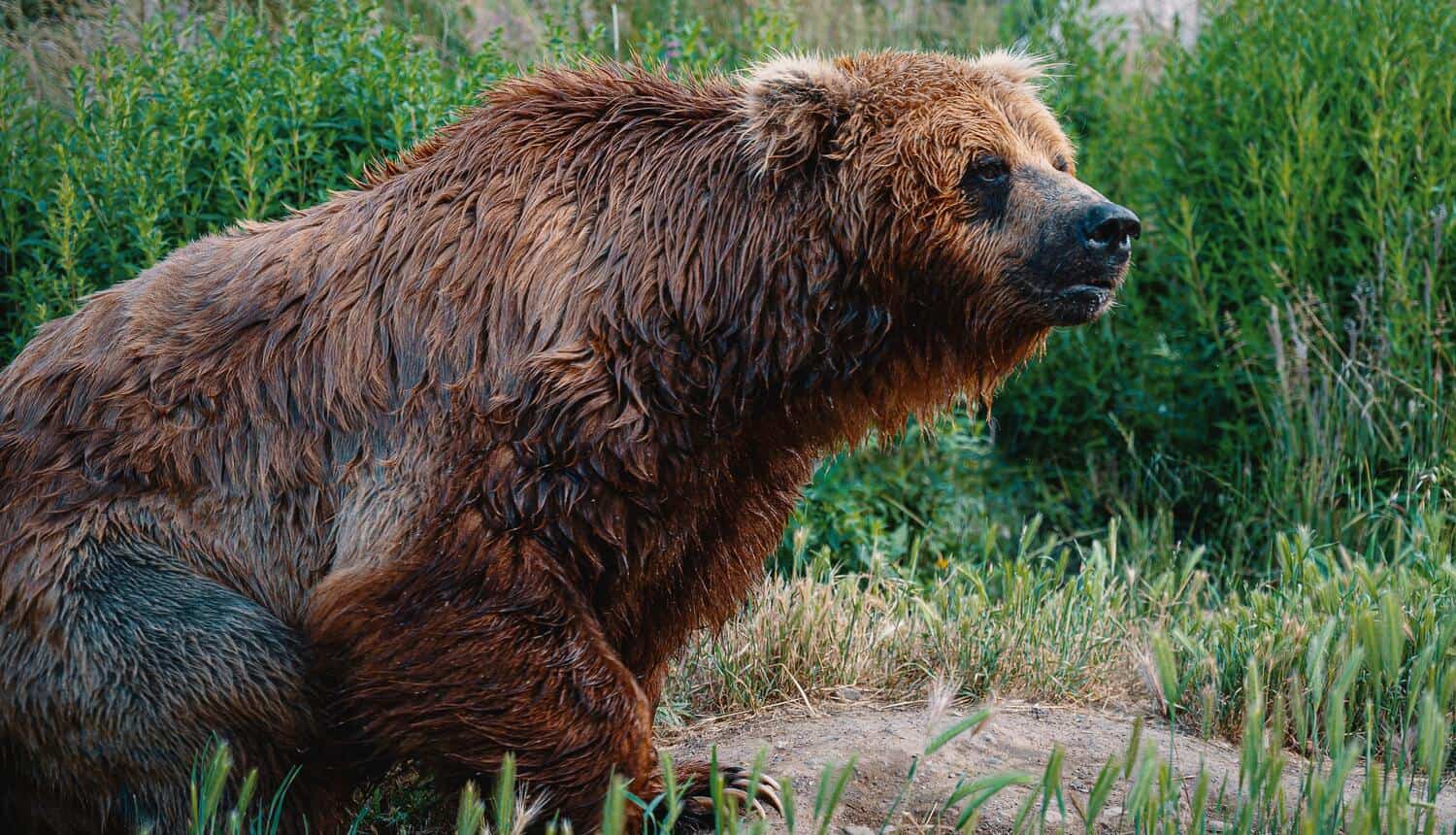
Just keep in mind our three simple steps when using bear spray:
- Store It Right: Don’t put it in direct sunlight, and check the expiration date.
- Keep It Nearby: Clip it to your belt when walking, and keep it close at night.
- Check The Wind: Never spray into a headwind; it can blind you instead.
That last tip also applies to your hiking buddies. You don’t want the bear spray to blow back and blind one of them either.
As it’s more powerful than pepper spray, it can cause a very severe reaction in humans.
(Some have asked: is it legal to use bear spray on humans? While it won’t cause permanent injury, you should stick to pepper spray for protection in cities and only use it if someone directly threatens you.)
6. Lie Face Down (Only If Knocked Down)
This step is a last resort, and you should only follow it in the unlikely event that steps 1 to 4 fail. Perhaps your bear spray (your best defense) was faulty, or perhaps you forgot to bring it.
If a bear approaches you and manages to knock you to the ground, you should always lie face down and cover your neck with your hands.
NOTE: Remember, only do this if you are knocked down. You should get to your feet as soon as possible and then attempt to push the bear away from you while shouting. Being on your feet gives you more options to escape, and you are more likely to be able to deter the bear from continuing with the attack.
By lying face down, you will better withstand any scratches or blows from the bear. Lying face down is safer than adopting the fetal position in a bear attack. This is because your back is much less vulnerable than your front, sides and face.
If you’re wearing a backpack, this will give more protection, shielding you from the bear’s aggression.
Your neck, however, is the most exposed and vulnerable part of you when you’re lying face down. That’s why it’s vital to protect your neck with your hands if a bear attacks.
Keep in mind that having functioning bear spray with you at all times is the best way of avoiding this worst-case scenario.
Bear spray will give you many more defensive options when considering what to do if you see a bear.
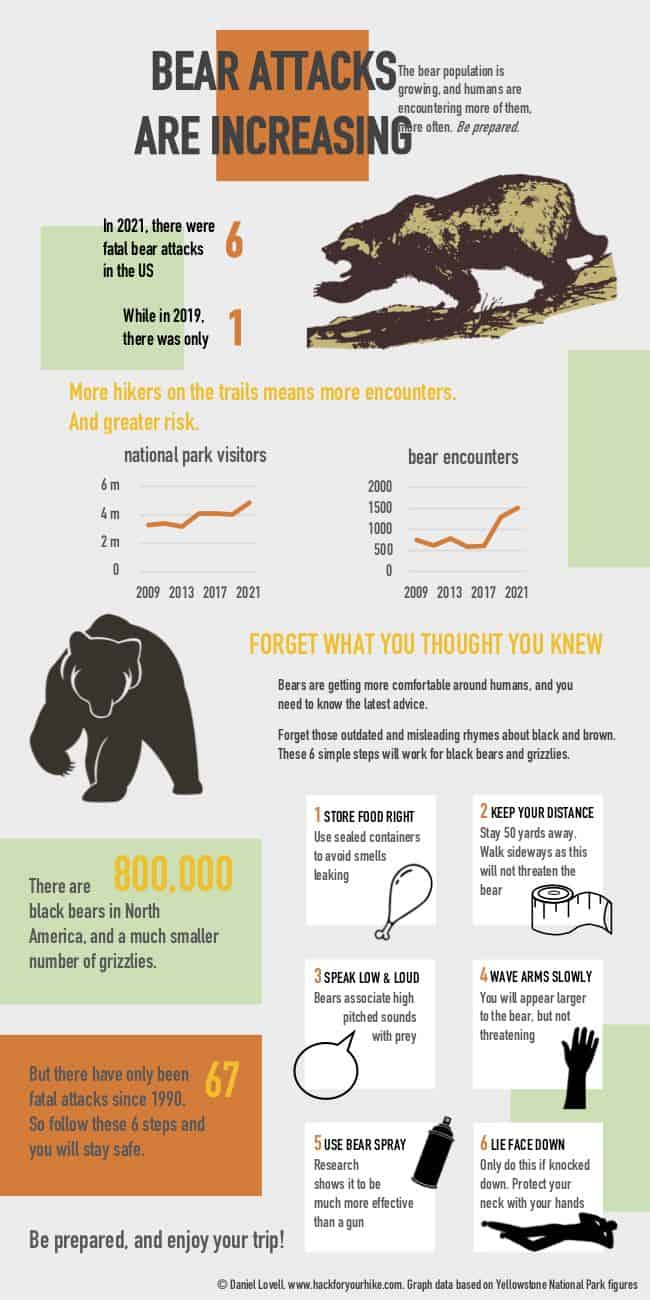
How Likely Am I To Encounter A Bear?
Humans are running into bears more often because of a convergence of two unrelated trends. On the one hand, the bear population is rising.
In 2000, there were an estimated 600,000 bears (black bears and grizzly bears) in North America. By 2020, that figure had passed 800,000.
This sizable rise is mainly due to effective reintroduction programs and careful environmental stewardship in recent years.
At the same time, there has been a significant increase in hiking and camping. National park data shows that visits were increasing even before the pandemic hit.
Once it did, they skyrocketed still further. With everyone cooped up indoors during the lockdown, we were desperate to get out into the great outdoors. When things calmed down, more of us than ever before did just that.
In Yellowstone National Park alone, visitors went from around 4 million in 2019 to almost 5 million in 2021.
That’s a bigger jump than at any point in the last 20 years, despite steady increases since 2000.
Given these trends, it’s no wonder that people are running into bears more often:

In the graph above, “encounters” refers to non-violent human/bear interactions and sightings. Data is estimated and based on U.S. national park figures.
The recent increase in the number of human/bear close encounters has resulted in a rise in fatal attacks, from 1 in 2019 to 6 in 2021.
But don’t worry!
This number is tiny compared to the total number of hikers and bears in the wild. You are extremely unlikely to come across a predatory bear. Most bears are more scared of you than you are of them, and they are very unlikely to attack humans.
See also: Panda Bears in Chengdu (China)
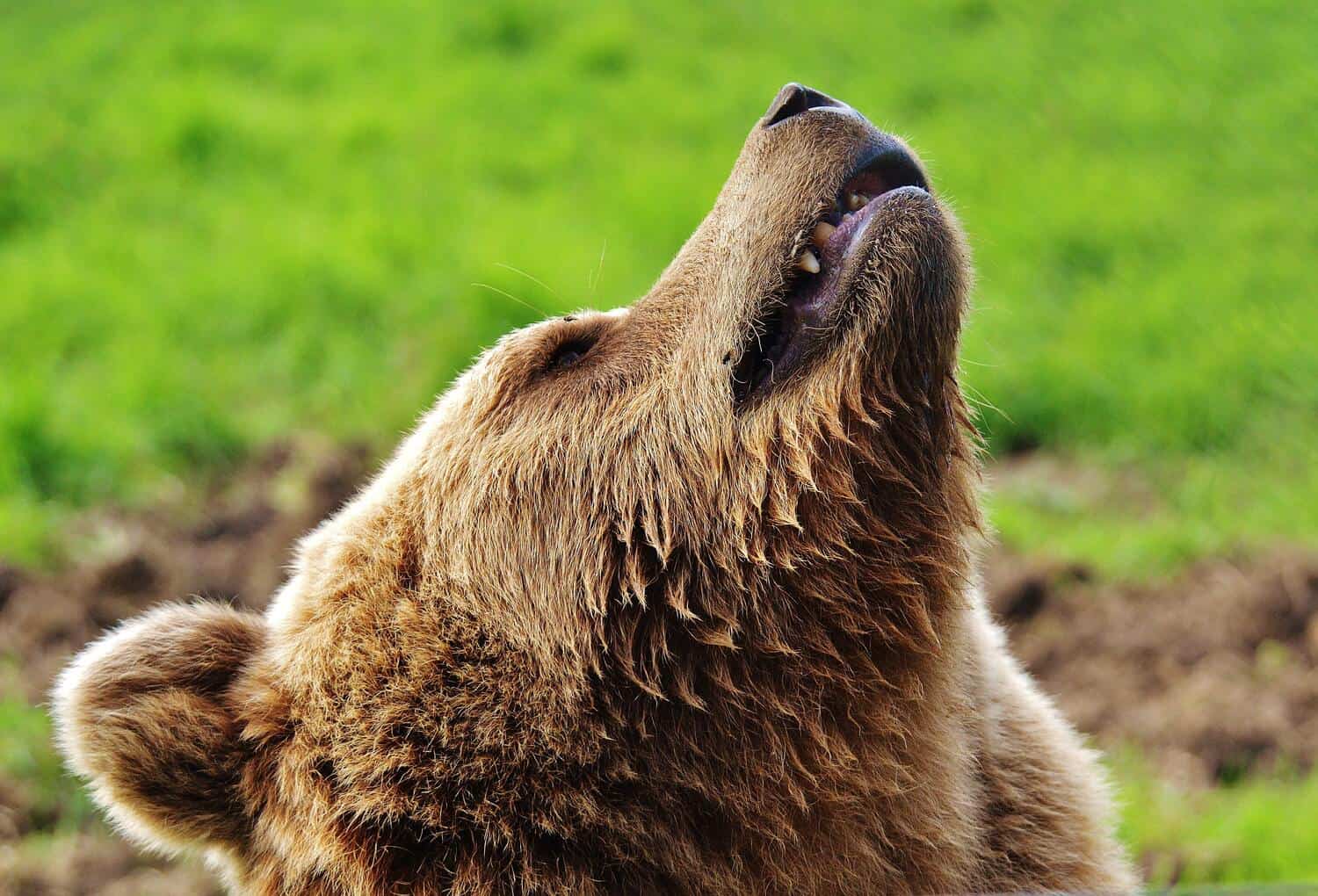
Be Prepared, And Have Fun
So, if you’re asking yourself what to do if you see a bear while running or hiking, remember this essential advice: always have bear spray with you.
The good news is that, if you’ve got your bear spray and you follow the five other tips in this article, you’re bound to have a safe and fun trip.
For more hiking safety tips, check out this list of essential safety tips for your next trip. See you on the trails!
Passionate hiker and traveler. Founder of hackforyourhike.com.
Planning a trip? Go Backpacking recommends:
- G Adventures for small group tours.
- Hostelworld for booking hostels.
